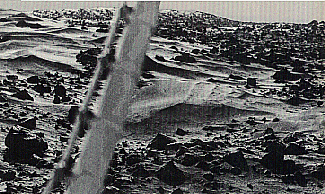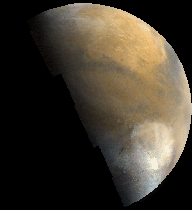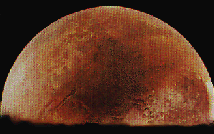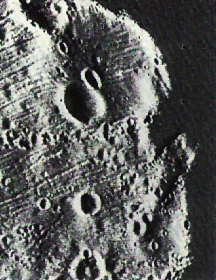

TES News
August/September 1992, Volume 1, No. 3
Thermal Emission Spectrometer Project Mars Observer Space Flight Facility Department of Geology, Arizona State University Box 871404, Tempe, Arizona 85287-1404, U.S.A.

Mars, the fourth planet from the Sun, has long held a place of special fascination. It has been an object of scientific inquiry, speculation, and fantasy for more than five centuries.
Mars takes 687 Earth days to circle the Sun. Because the planet's axis is tilted 25.2 degrees (the Earth's is tilted 23.5 degrees), Mars experiences changing seasons, similar to those on Earth. For example, polar ice caps grow in the winter and retreat in spring, and warm summer winds raise occasional dust storms. The climate of Mars is that of a cold, arid desert. The air, composed of 95% carbon dioxide, is so thin (only 7 thousandths the Earth's atmospheric pressure at sea level) that liquid water cannot presently exist at the surface. Typical Summer temperatures rarely get above 32 F (0 C), the yearly average temperature is only -67 F (-55 C), and in winter it is cold enough to freeze carbon dioxide at the poles (-193 F; -125 C).
The U.S. spacecraft, Mariner 4, was first to fly past the Red Planet in 1965. The mission put to rest most hopes of finding intelligent life or even simple plant life on Mars: the landscape resembled the dead, cratered surface of the Moon. Additional pictures from the flybys of Mariners 6 and 7 in 1969 confirmed this view.
Mission Year Type Country Mariner 4 1965 flyby USA Mariner 6 1969 flyby USA Mariner 7 1969 flyby USA Mariner9 1971-72 orbiter USA Mars 2 1971-72 orbiter/lander USSR Mars 3 1971-72 orbiter/lander USSR Mars 4 1973-74 orbiter USSR Mars 5 1973-74 orbiter USSR Mars 6 1973-74 lander USSR Mars 7 1973-74 lander USSR Viking 1 1975-82 orbiter/lander USA Viking 2 1975-80 orbiter/lander USA Phobos 2 1988-89 orbiter USSR Mars Observer 1992-95 orbiter USA
Mariner 9 arrived at Mars in late 1971, while the planet was in the midst of a global dust storm. After the dust settled in early 1972, Mariner 9 provided the first complete mapping of the planet's surface. The New Mars, as it was called, was found to have giant, inactive volcanoes. One volcano,Olympus Mons, is taller than Mt. Everest and wide enough to cover the entire state of Arizona! A vast canyon system, named Valles Marineris after its robot discoverer, is so long that it would stretch from New York to Los Angeles, and is four times deeper than Arizona's Grand Canyon. Mariner 9 also found a variety of channels or ancient, dry riverbeds, some of which formed by vast catastrophic floods, others perhaps by the slow seepage of groundwater. A variety of dust storms and a number of dark-hued sand dunes were also observed.
Following Mariner 9, the study of Mars was extended down into the soil in an effort to find microscopic martian life. The ambitious Viking Project consisted of two orbiters and two landers. A celebration of the U.S. bicentennial, Viking I landed on Chryse Planitia on July 20,1976. Viking 2 touched down in the Utopia Planitia on September 3, 1976.
The surface of Mars seen by the Viking 1 lander in July 1976.

Both Viking landing sites were vast, rock-strewn plains of red soil and pink skies. The Viking landers found no conclusive evidence for martian life,however even today some scientists speculate that life may exist deep underground, near subsurface ice or groundwater areas, or perhaps might be evident as ancient fossils in martian sedimentary rocks.

Day = 24 hrs. 36 mins.
Year = 687 Earth days
Atmosphere = 95% Carbon dioxide, 2.7% Nitrogen,
2.3% others
Atm. Pressure = 0.007 of Earth's
Gravity = 3.73 m/s^2 or 0.4 of Earth's
Diameter = 6785 km
Dist. from Sun = 207 - 249 km (128 -155 mi.)
(in millions)
2 Moons = Phobos and Deimos
The most successful Soviet missions to Mars were Mars 5
and Phobos 2. Mars 5 returned a suite of Mariner-quality
photographs in 1974. Phobos 2 was the only spacecraft to
reach Mars in the l980's. It returned a modest amount of data
between January 1989 and its sudden failure in March 1989.
Viking photograph of martian moon Phobos.

The next mission to Mars, the U.S. Mars Observer, is set for launch in September 1992. The spacecraft will systematically map the Red Planet over the course of an entire martian year (687 Earth days), allowing scientists for the first time to obtain a detailed understanding of how the martian surface and atmosphere change over a complete seasonal cycle. Mars Observer will also significantly improve our knowledge about the planet's composition and topography.
Russian scientists, in cooperation with groups in Europe and the U.S., are planning two ambitious, robotic missions to the Red Planet, Mars 94 and Mars 96. To be launched in 1994 and 1996, respectively, these spacecraft will include instruments that will land on the surface; plans call for at least one rover vehicle and a balloon that will drift with the martian winds. The new Russian government has assured funding for at least the 1994 mission. NASA scientists are in the planning stages for a mission (not yet funded by the Congress) called the Mars Environmental Survey (MESUR). The MESUR program would place a network of saucer-shaped landers on Mars beginning as early as 1998.
In 1989, President Bush urged a human mission to Mars by 2019, the 50th anniversary of the Apollo 11 Moon landing. Such a mission would probably result from the combined political and economic will of several nations. The planning of such a mission will rely upon the detailed picture of Mars gleaned through the Mars Observer, Viking, Mariner, Phobos,and Mars experiences.
K.S. Edgett
Written by:
Text prepared by:T.E. Montoya and K.S. Edgett
Original Text: August 1992
Hypertext Version: January 27, 1994
Update1: January 29, 1994
Update2: April 24, 1994